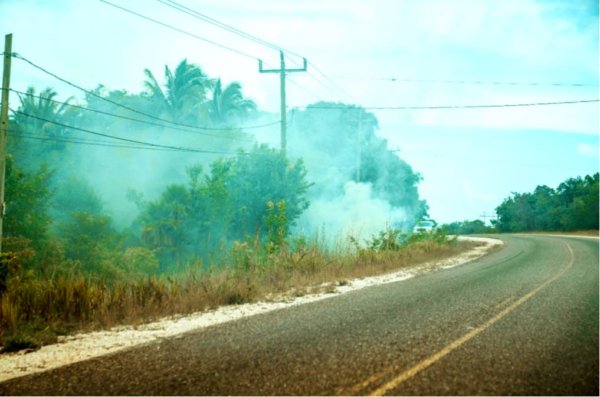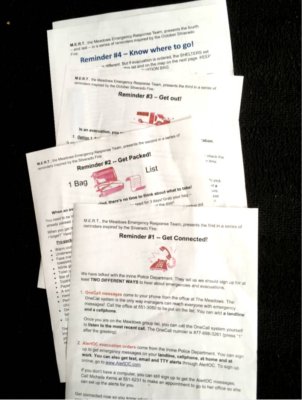
Sometimes you think you’re pretty well up to speed on preparedness – and then a real emergency hits. You get the chance to see how your plan holds up. Today, I want to tell you about the recent breakdown of our evacuation plan – and what we’ve done about it since.
(Oh, I know the saying that “No plan withstands first contact with the enemy.” Source? Graf Helmuth von Moltke, Prussian field marshal during Franco-Prussian war of 1870, known as Moltke the Elder – just in case you wanted to know. I always want to know these things.)
But back to the story of our evacuation plan breakdown. It happened only two months ago.
Not only did our plan break down, but we discovered we hardly had a plan at all!
It’s taken us a while to dig out from under, but now’s the time to share just what we discovered and what we had to do as a result.
My goal is to encourage you to spend some time looking at your own emergency response plans to see if you can spot some holes.
If your plans are as bad as ours were, you’ll want to take remedial action!
What happened that day. . .
You’ll recall earlier Advisories about our “near miss” with a wildfire in the final weeks of October. It was during one of Southern California’s well-known Red Flag (high wind) events. A vegetation fire started in the early morning. By afternoon it had exploded to over 5,000 acres – and it was barreling right toward our town.
Evacuation orders were issued and extended, covering zone after zone of the town. By 5 pm they had reached the apartment complex right across the street from us.
I’ve detailed a lot of what we were doing that day to alert neighbors, keep them up to date with evacuation warnings and orders, where shelters were being set up, etc. (If you didn’t read my “Diary” of that day, please do. I think you’ll find it useful to get the blow by blow.)
As it turned out, late in the afternoon the winds changed direction. We never got a mandatory evacuation order.
But by 5 pm we had learned a whole lot of why evacuation would never have worked.
In the following four weeks we learned even more. Here were the realities in our senior retirement community:
- More than half of our neighbors received no emergency alerts. Either they hadn’t signed up, or they’d turned them off. By afternoon everyone did realize that there was a fire because of the heavy smoke in the air.
- The 30% (or more) of our community without internet access had no idea about evacuation routes or where shelters were to be found. (The shelter location map put out by the city was excellent – but it was online.)
- Around 40% of our neighboring households could not evacuate without assistance, i.e. help with physically getting out of the house, or help with transportation. We didn’t know who they were.
- Neighbors with pets had no emergency supplies: crates or carriers, leashes, and ID papers that would allow the pets to accompany their owners to shelters, hotels, etc.
- Despite multiple calls to various city offices, we got no useful answers about what official help to expect.
We are a community that has actually won awards for being so well prepared! How could so many failures have existed?
The answer is amazingly simple.
Over 10 years ago, following multiple wildfire tragedies, our neighborhood emergency response group hosted a series of meetings. Local fire department, police, utility companies, community managers, and experienced neighborhood response group members attended.
We discussed how to evacuate the community. We identified many of the same issues that are listed above. It was agreed that evacuation would be so challenging that it would have to be the very last resort. Professionals advised us that our energy would be best used helping neighbors be ready to shelter in place.
So for the past 10 years, that’s what we have done!
What we did differently after this evacuation plan breakdown.
Our “near miss” was so traumatic that Joe and I wasted no time is raising the alarm. We wrote to the mayor. We gathered more facts by surveying neighbors and the property managers via phone, zoom and email. We contacted our city’s emergency manager, who helped pull together a virtual meeting that included all the key players, just as had happened years ago.
This time, the results were different.
First, we discovered that a new evacuation plan for the city had actually been completed just before COVID hit! The shutdowns meant that where we normally would have had a community meeting to reveal the plan, it never happened.
Second, members of our group spent hours tracking down the answers to questions that still remained. The next step was to share this information.
Getting more information out to the community.

The only way we have of reaching all our neighbors is via flyers. Accordingly, members of our neighborhood emergency response team researched, wrote, duplicated and distributed a series of flyers – in multiple languages — to all 360 homes in our community.
(Photo of actual flyers, slightly crumpled and purposefully blurred since they contain phone numbers specific to our community. See more details below.)
The flyers reminded people that they are responsible for their own evacuation . . . and urged them to take immediate steps to be more prepared.
- Flyer #1: Get Connected! reminded people how to sign up for various emergency alert programs and suggested multiple sources for emergency news.
- Flyer #2: Get Packed! reviewed the importance of having an already packed evacuation Go-Bag and listed what needs to be in it. (Supplies for pets, too.)
- Flyer #3: Get Out! listed evacuation transportation options, with particular guidance for people who need assistance. Most important: make sure your needs are known before an evacuation is called! By the way, here was my original sentence that the Fire Department asked me to soften, “If you refuse to leave, First Responders will not come back for you.” (Even though it’s the truth!)
- Flyer #4: Know where to go! provided a map of our city showing likely shelters, complete with addresses and phone numbers. (This was particularly for neighbors who do not own cell phones.)
Our flyers were written specifically for our community, taking into consideration its cultures and languages, ages, role of property managers, and resources of our city. If you have questions, or would like to see the actual flyers, just let me know.
For the time being, we’re confident that our community’s evacuation plans have been strengthened. Now our job will be to repeat and remind neighbors of all its recommendations – without overlooking the continuing emphasis on shelter in place.
What should be your next steps?
I urge you to take another look at your family’s evacuation plan and at the same time, your community’s evacuation plan. After all, one doesn’t exist without the other. Ask a lot of questions! “What do we do if . . .?” “Where do we go if…?” If you have questions with no good answers, become an “activist.” Get to know your city’s emergency manager!
I can assure you, you won’t forgive yourself for an evacuation plan breakdown.
Virginia
Your Emergency Plan Guide team
P.S. This Advisory has touched on just a few aspects of evacuation. I hope you’ll consider getting our Mini-series book on the topic. It covers more questions and offers answers that may fit. (Click the link above, scroll down on the page until you get to Evacuate!)
Don't miss a single Advisory.
Thank you for subscribing.
Something went wrong.
